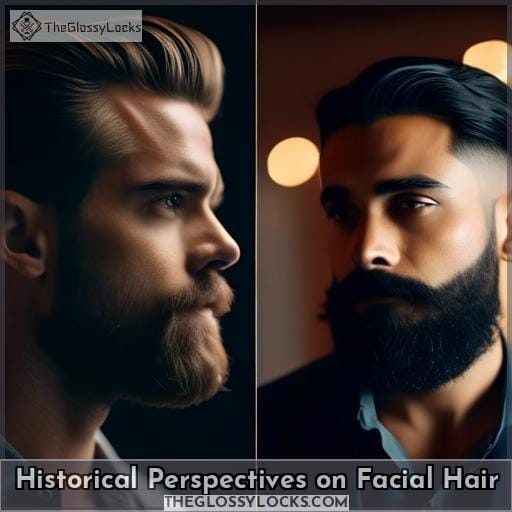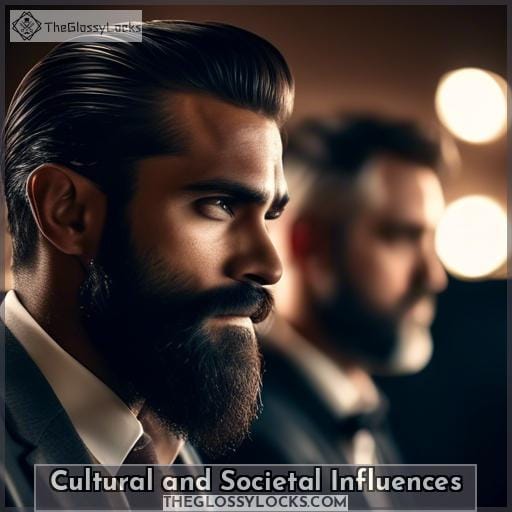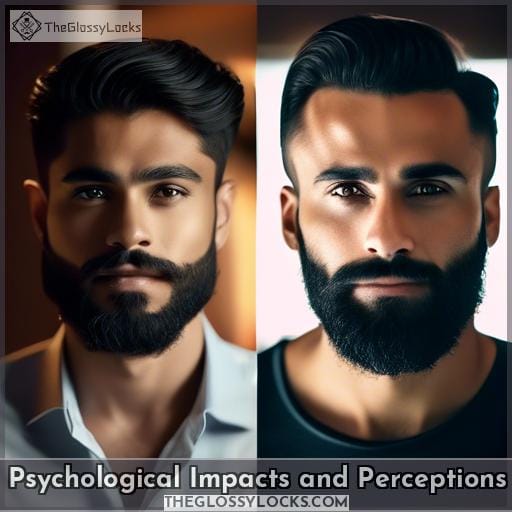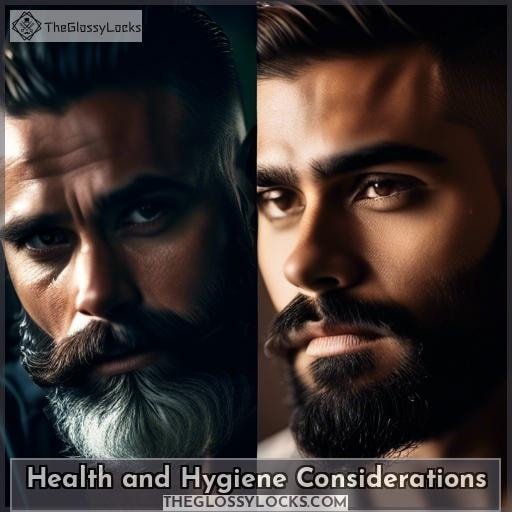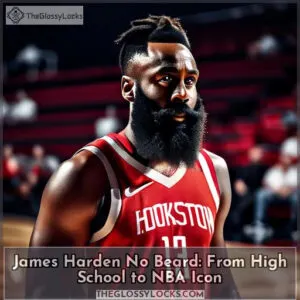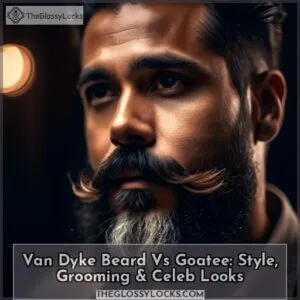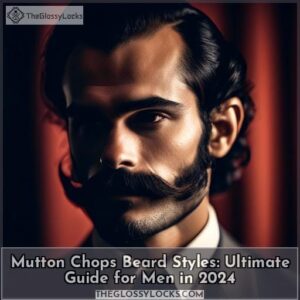This site is supported by our readers. We may earn a commission, at no cost to you, if you purchase through links.
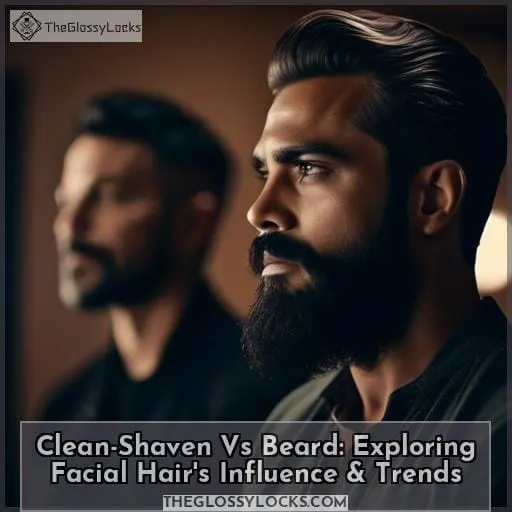 Navigating the tides of masculinity, your face is the canvas where power and control are etched in the lines of your beard or the smoothness of your shave.
Navigating the tides of masculinity, your face is the canvas where power and control are etched in the lines of your beard or the smoothness of your shave.
You wield the razor or sheath it, shaping not just your image but echoing societal trends and personal dominion.
Whether you embrace the rugged allure of a beard or the sleek command of being clean-shaven, each stroke reflects a choice that resonates with influence and trends in facial hair’s dynamic landscape.
Table Of Contents
- Key Takeaways
- Historical Perspectives on Facial Hair
- Cultural and Societal Influences
- Psychological Impacts and Perceptions
- Health and Hygiene Considerations
- Trends and Future Directions
- Frequently Asked Questions (FAQs)
- How does having a beard or being clean-shaven affect the wear and fit of personal protective equipment, such as masks or respirators?
- Are there any specific career fields or professions where having a beard or being clean-shaven significantly impacts job performance or safety?
- What are the environmental impacts of shaving products and practices compared to maintaining a beard?
- How does facial hair affect the skin’s aging process, such as the development of wrinkles or sun damage?
- Can facial hair have any significant impact on athletic performance, such as creating aerodynamic drag or affecting sweat evaporation?
- Conclusion
Key Takeaways
- Beards are perceived to enhance men’s dominance, aggression, and social status, but preferences for facial hair vary and are influenced by one’s own facial hair status.
- Bearded men can shed more bacteria than clean-shaven individuals, which may have implications for hygiene, especially in healthcare settings.
- A clean-shaven appearance is often associated with professionalism, confidence, and trustworthiness, and is considered the most hygienic option.
- Facial hair trends are influenced by a variety of factors including fashion, religious values, political agendas, and personal style, with clean-shaven looks being a timeless classic that periodically returns to popularity.
Historical Perspectives on Facial Hair
Throughout history, your beard—or lack thereof—has spoken volumes before you’ve even muttered a hello. It’s been a canvas for Symbolism and Identity, with every twist and twirl or clean-shaven cheek telling a tale of its own.
Imagine the ancient Egyptians, who combed sophistication into their beards, turning them into status symbols. Or picture the knights of the Middle Ages, for whom a beard was a badge of honor, so much so that a duel could erupt over an unsanctioned touch.
Fast forward to the Renaissance, and the beard becomes the centerpiece of Self-Perception, defining manhood with every strand. Even the Romans got in on the act, with a clean shave distinguishing them from their Greek counterparts—until a scarred emperor flipped the script and brought beards back into vogue.
Now, let’s not forget the Religious Beliefs and Regional Customs that have shaped facial hair trends. From the long, flowing beards of Mesopotamian rulers to the Spartans’ strategic shaves, beards have been intertwined with power and piety.
And it’s not just about looking the part; your beard could even impact how you’re perceived, with Facial Expressions sometimes hidden or highlighted by your facial fuzz.
So, whether you’re sporting a full Gandalf or going baby-faced, remember that your choice is part of a rich tapestry woven through time, influenced by the ebb and flow of cultures and the desire to master one’s image.
Keep that chin up—bearded or not—and carry the legacy of your forebears with pride.
Cultural and Societal Influences
As we’ve journeyed through the annals of history, observing the ebb and flow of facial hair fashion, it’s clear that the whiskers on one’s chin are more than mere follicles. They’re a canvas, painted by the broad brushstrokes of cultural norms and societal expectations.
Now, let’s pivot to the present, where your beard—or lack thereof—can speak volumes before you’ve uttered a word.
In the tapestry of today’s society, grooming practices aren’t just about looking sharp; they’re a chess move in the social arena. Sporting a beard might be your checkmate in the game of first impressions, signaling a rugged individualism or a nod to religious beliefs.
Yet, in the same breath, a clean shave might align you with the rank and file, adhering to the unspoken dress code of the corporate battlefield.
Gender perceptions, too, are woven into this narrative, where a man’s mane can be a silent proclamation of masculinity or a subtle rebellion against the clean-shaven status quo. But remember, with great beard comes great responsibility. It’s not just about letting it grow wild and free; it’s about mastering the art of maintenance, keeping those whiskers well-oiled and trimmed, lest you fall prey to the dreaded beardruff.
So, whether you’re a bearded bard or a smooth-faced sage, remember that your facial hair—or its absence—is a powerful tool in the art of non-verbal communication, a reflection of your personal brand in the ever-watchful eyes of society.
Psychological Impacts and Perceptions
As you’ve seen, cultural and societal influences shape how facial hair is perceived, but let’s dive into the psychological arena. Sporting a beard or going clean-shaven isn’t just a style choice—it’s a statement about your self-confidence and perceived social status.
A full beard might be your ticket to radiating dominance and masculinity, a silent nod to your alpha status in the room. It’s like wearing a suit of armor made of hair; it can amplify your personality perception and give you that edge of authority.
But it’s not all about power plays. Beards can be a canvas for self-expression, a way to showcase your unique style and creativity. Think of it as your face’s personal billboard, advertising your individuality. And let’s not forget the confidence boost that comes from those admiring glances and compliments on your well-groomed mane.
On the flip side, a clean shave can signal a fresh, youthful vigor, a readiness to face challenges head-on without hiding behind bristles. It’s a nod to traditional professionalism, a way to say, I’m here, I’m clear, and I mean business.
Whether you’re a bearded bard or a smooth operator, remember that your facial hair—or lack thereof—speaks volumes before you even utter a word. It’s a part of your personal brand, a piece of the puzzle that’s your social signature.
Health and Hygiene Considerations
When considering the health and hygiene implications of facial hair, it’s crucial to weigh the benefits and risks.
Opting for a clean-shaven look can reduce skin irritation and promote enhanced hygiene practices, as beards can trap dirt and potentially harmful microorganisms.
However, maintaining a beard requires diligent grooming to mitigate the risk of facial hair contamination, ensuring both style and cleanliness are preserved.
Skin Irritation Reduction
When it comes to mastering the art of a clean-shaven look or a well-groomed beard, understanding the role of skin irritation reduction is crucial. It’s not just about looking good; it’s about feeling powerful and in control of your grooming routine.
- Embrace the power of moisture: Keeping your skin hydrated is like giving it armor against irritation. Think of it as your secret weapon for a smooth, irritation-free face.
- Know your battlefield: Understanding your hair growth patterns and how they affect your skin can turn the tide in the battle against redness and bumps.
- Guard your fortress: Regular skincare routines fortify your skin’s defenses, ensuring that follicle health is maintained and your face remains a stronghold of comfort and style.
By focusing on these strategies, you’re not just avoiding discomfort; you’re taking command of your appearance and how the world sees you.
Enhanced Hygiene Practices
When it comes to mastering your grooming habits, diving into the world of beard removal and hygiene standards isn’t just about looking sharp—it’s about wielding the power of cleanliness. Think of your face as the ultimate canvas, where every stroke of the razor or trimmer is a statement of your mastery over your personal hygiene and appearance.
It’s not just about infection prevention; it’s about setting the bar high for cleanliness perceptions and showing the world you’re not one to mess with when it comes to looking and feeling your best.
Beard removal isn’t just a chore; it’s an art form—a ritual that separates the men from the boys. Whether you’re a seasoned pro or a novice in the world of facial hair, embracing enhanced hygiene practices is your secret weapon.
It’s about more than just avoiding the dreaded beardruff or steering clear of facial hair contamination risk; it’s about taking control, asserting your dominance over those unruly whiskers, and showing them who’s boss.
So, as you navigate the waters of grooming habits, remember, it’s not just about the act of removal; it’s about the why and the how. It’s about making a statement with every shave, trim, or wax. It’s about hygiene standards that don’t just meet the mark—they set it.
And in the grand scheme of things, isn’t that what we’re all striving for? To be the masters of our own domains, with the power to influence, control, and, yes, even inspire with our grooming choices.
So, wield that razor with pride, my friend, because in the world of beard removal, you’re not just cleaning up your face—you’re taking charge of your destiny.
Facial Hair Contamination Risk
While you’ve been diligently keeping your beard clean to ward off bacteria, there’s a twist in the tale. Beards can indeed be double agents, harboring a secret party of microbes that could potentially gatecrash your respiratory health.
Think of your facial hair as a bustling hotel for bacteria, with the risk of disease transmission checking in alongside. Despite your best efforts, bacteria accumulation is like unwelcome glitter – it sticks.
Infection susceptibility isn’t just a buzzword; it’s a real concern, especially if you’re in the healthcare field where mask effectiveness is paramount. So, while you might feel like a bearded maestro, remember that your facial fortress could be less of a shield and more of a Trojan horse when it comes to contaminants.
Trends and Future Directions
As you navigate the ever-evolving landscape of facial hair, consider these four key points:
-
Shaving Habits: Your daily ritual might be more than just a routine; it’s a statement. The razor you choose, the strokes you make, they’re all part of the dance of grooming. Are you the type to keep it smooth and clean, or do you let your stubble bloom into a full beard?
-
Beard Styles: From the rugged full beard to the precise goatee, your facial hair can shape perceptions. It’s like choosing an outfit for your face. Will you go for the classic look that whispers wisdom, or the edgy style that screams trendsetter?
-
Facial Aesthetics: It’s not just about the hair, but how it frames your mug. A well-groomed beard can be the bow on the package, enhancing your features. Think of it as contouring for men; it’s all about playing up your best angles.
-
Grooming Norms & Hair Removal Technology: The tools of the trade are getting sharper, more efficient. With cutting-edge tech, you can sculpt your facial topiary with the precision of a master gardener. Will you stick with the tried and true, or experiment with the latest gadgetry?
Frequently Asked Questions (FAQs)
How does having a beard or being clean-shaven affect the wear and fit of personal protective equipment, such as masks or respirators?
Beards can compromise the seal of tight-fitting masks and respirators, reducing protection.
Clean-shaven faces ensure a proper seal and compliance with safety standards like OSHA’s.
Are there any specific career fields or professions where having a beard or being clean-shaven significantly impacts job performance or safety?
In fields like healthcare and emergency services, being clean-shaven is crucial for safety.
In corporate settings, a smooth face might fast-track promotions.
What are the environmental impacts of shaving products and practices compared to maintaining a beard?
Shaving’s not just about looking sharp; it’s about making smart choices for our planet.
Disposable razors and aerosol cans pile up in landfills, taking centuries to decompose. Opting for a beard? Remember, those grooming products mightn’t be as green as you think, with synthetic ingredients and plastic packaging adding to environmental woes.
But here’s the kicker: embracing traditional shaving or natural beard care can slash your environmental footprint. So, whether you’re sporting a smooth chin or a full beard, choosing eco-friendly products isn’t just good grooming—it’s a power move for the planet.
How does facial hair affect the skin’s aging process, such as the development of wrinkles or sun damage?
Your beard might be a knight in shining armor for your skin, shielding it from the ravages of time and the sun’s harsh rays.
Facial hair can protect against UV radiation, potentially reducing photoaging and the development of wrinkles.
Can facial hair have any significant impact on athletic performance, such as creating aerodynamic drag or affecting sweat evaporation?
Facial hair can impact your game. A study showed NFL quarterbacks with beards had higher ratings than when clean-shaven.
However, for cyclists, that bushy beard might slow you down by increasing aerodynamic drag.
Conclusion
Stepping into the annals of history, the debate between being clean-shaven and sporting a beard has always been more than just a matter of personal grooming; it’s a reflection of the times, a statement of identity, and a nod to societal norms.
As you’ve navigated through the influences, perceptions, and trends surrounding facial hair, it’s clear that the choice between a beard and a clean-shaven look is deeply personal yet universally impactful.
Whether you opt for the rugged charm of a beard or the polished allure of being clean-shaven, your face tells a story that resonates with cultural significance and personal sovereignty.
- mountainbeards.com
- thefashionwolf.com
- milkmanaustralia.com

